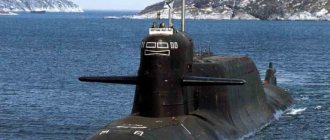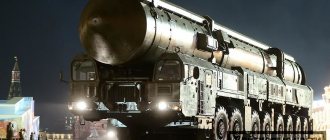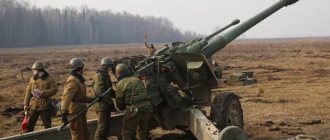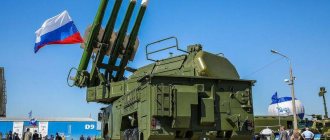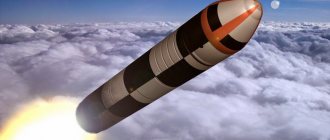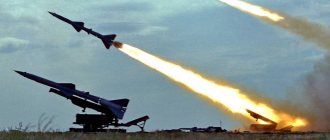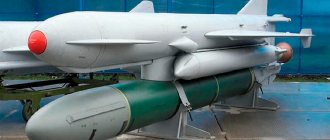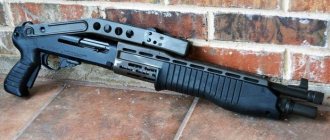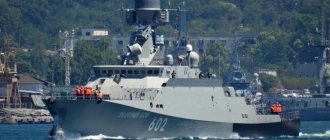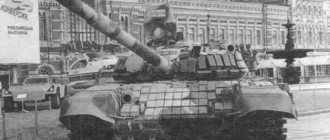How the Strategic Missile Forces developed
On June 21, 1956, the USSR adopted the R-5M, the first domestic missile with a nuclear charge. Over the past 60 years, a number of unique “products” have been deployed on combat duty. Now the Strategic Missile Forces are introducing a missile system that is more advanced than the Topol-M.
Strategic but close-minded
The R-5M, developed at OKB-1 by S.P. Korolev, is a medium-range ballistic missile. The maximum distance over which it was capable of delivering a one-megaton nuclear charge was 1,300 km. The maximum deviation from the target was 3.5 km.
The R-5M was a single-stage liquid-propellant rocket.
A total of 48 missiles were manufactured, which entered service with 15 regiments of the Strategic Missile Forces. Production of the missile ended in 1959, but it was on combat duty until 1966.
R-5Ms were based on the western borders of the country and were aimed at Paris, Brussels, Bonn and the Ruhr industrial region of Germany.
In March 1959, the R-12, developed by the Yangel Design Bureau, began to enter service, having a range of 2080 km, a maximum deviation of 5 km and a charge of 2.3 Mt. 2,300 of these missiles were produced and were on combat duty until 1989. However, not all R-12s entered the Strategic Missile Forces; some of the missiles were used in various space programs.
The fundamental difference between the R-12 and the R-5 was that the missiles were equipped with ground-based launch systems. They were also based in mines.
In 1962, three missile regiments armed with the P-12 were stationed in Cuba, leading to the Cuban Missile Crisis.
The class of medium-range missiles also included the R-14, which entered service in 1961. Their range has increased to 4500 km.
Delivery anywhere in the world
In 1960, the RSVN received two-stage intercontinental ballistic missiles (ICBMs) R-7 and R-7A, capable of delivering a thermonuclear charge with a power of 3 Mt to a distance of up to 11 thousand km with a maximum deviation of 10 km. This truly masterpiece, created under the leadership of S.P. Korolev at OKB-1, was universal. The rocket launched many satellites into space and delivered the first manned spacecraft into orbit. And it still “works” in a somewhat modernized form in the field of manned space flights.
Following the R-7, the R-16, R-9A, R-36, UR-100K, RT-2 appeared... The range exceeded 17 thousand km. The warhead increased to 10 Mt. Moreover, one missile was capable of delivering several warheads. Like, for example, the 8K67P missile, which had three multiple parts, each of which carried a charge of 2.3 Mt and had means to counter enemy air defenses. The missiles were both silo-based and ground-based. Along with liquid-fuel missiles, solid-fuel ballistic missiles began to enter service with the Strategic Missile Forces in the late 60s.
Taking into account the arsenal of Soviet submarine nuclear missile carriers in the “best years,” that is, before the signing of the Soviet-American nuclear arms reduction treaties, the USSR had 45 thousand warheads of varying power.
On the ground, underground and on rails
One of the main principles of the effectiveness of strategic missile forces is their invulnerability to enemy attacks. Which presupposes, first of all, the secrecy of the location. This problem is best solved by placing nuclear warheads and their delivery vehicles on submarines with a significant autonomous navigation resource. However, the Soviet Union decided to place the main emphasis on land-based strategic forces. In addition, for a long time we were losing to the United States not only in quantity, but also in quality of strategic nuclear submarines.
At the end of the fifties, when the RSVN was just unfolding (strictly speaking, at that time they had a different name), the problem of secrecy was not acute. The missiles were installed directly at the Kapustin Yar test site. When spy satellites appeared, rockets began to be “buried in the ground,” that is, placed in mines. At the end of the 60s, mobile missile systems began to be developed, constantly and secretly moving to avoid detection.
In 1975, the RSVN units began to receive the Temp-2S strategic mobile ground-based missile systems (GGRK), created at the Moscow Institute of Thermal Engineering. They were equipped with a solid-fuel ICBM 15Zh42, weighing 40 tons and having a length of 18.5 m. The mobile launcher was placed on a six-axle MAZ-547A off-road wheeled chassis. In the 70s and 80s, according to various sources, from 50 to 100 Temp-2S complexes were put on combat duty.
This was the first sign. Development, testing and rigorous testing of the complex lasted 11 years. The creation of subsequent complexes, taking into account the experience gained, went faster. Already in 1976, production of the complex for medium-range missiles began - the Pioneer PGRK. It was in operation until 1991. In total, 509 complexes with 728 missiles were transferred to the Strategic Missile Forces. The modified Pioneer could control three launchers. According to NATO classification it was called SS-20.
In 1989, the Combat Railway Missile System (BZHRK) RT-23 UTTH “Molodets”, developed at the Yuzhnoye Design Bureau, began to move along the railways of the Soviet Union. It was equipped with solid-fuel ICBMs 15Zh61 and 15Zh60 with multiple warheads. By 1991, there were already 12 Molodtsovs with three launchers each. To date, all of them have been excluded from the Strategic Missile Forces and disposed of.
The BZHRK was a train camouflaged as an ordinary civilian technical train. Three carriages were disguised as ordinary passenger compartment cars, 14 – as refrigerators. There was a tank with fuel and lubricants. And also three diesel locomotives, hauling three missiles of 100 tons each. The BZHRK could move autonomously along railway networks for 28 days.
From the moment the order was received from the General Staff, 3 minutes were allotted for launching the rocket. The procedure was carried out as follows. The train stopped. A special device diverted to the side and grounded the contact wire. The launch container was in a vertical position. After that, a mortar launch of the rocket was carried out - with the engine turned off, it was “pushed” out of the container by gases. In the air, the rocket bowed out using a powder accelerator. And only after that the main engine was turned on - in order to avoid damage to the launcher engine and the railway track by the jet.
Current state
In accordance with a number of agreements between the USA and the USSR, and subsequently Russia, there is a gradual reduction in nuclear weapons, American and ours. At the moment, there is approximately equality of arsenals, but with a 5-10% advantage for the United States.
Let's consider Russia's strategic potential, or more precisely, its land component, which is in service with the Strategic Missile Forces. It, according to open sources, consists of 395 launch complexes with 1,339 warheads (data as of the beginning of 2013).
The R-36M2 Voevoda ICBM contains the largest number of warheads: 580 in 58 missiles. Another 420 warheads contain 70 UR-100N UTTH missiles. Both of them are modifications of ICBMs developed in the 70s, which entered the Strategic Missile Forces units in the late 70s - mid-80s.
A little “fresher” is the RT-2PM Topol mobile missile system, produced in 1988. 153 Topols contain 153 warheads.
Modern launch systems include the RT-2PM2 Topol-M, developed by the Moscow Institute of Thermal Engineering and put into service in 1997. The 15Zh65 missile used in it is no longer Soviet, but Russian-developed, has one warhead and 20 decoys to counter air defense. 60 silo-based and 18 mobile missiles contain 78 warheads.
And finally, the most modern development of the Institute of Thermal Engineering, adopted for service in 2009, is the RS-24 Yars mobile and silo-based launch complex. The intercontinental missile has three warheads with a yield of 300 kt each. Currently, 36 Yars complexes are deployed, armed with 108 warheads. It is assumed that in the foreseeable future the RS-24, together with the Topol-M, will form the basis of the strike force of the Strategic Missile Forces.
Photo by ITAR-TASS/Marina Lystseva.
Structure, composition and armament of the Strategic Missile Forces
Today, the Strategic Missile Forces includes three armies: the 31st (Orenburg), the 27th Guards (Vladimir) and the 33rd Guards (Omsk), consisting of twelve missile divisions, as well as the Central Command Post and the Main Headquarters of the Missile Forces.
In addition to military units, the Strategic Missile Forces include several training grounds (Kapustin Yar, Sary-Shagan, Kamchatka), two educational institutions (an academy in Balashikha and an institute in Serpukhov), production facilities and bases for storing and repairing equipment.
Currently, the Strategic Missile Forces of the Russian Armed Forces are armed with 305 missile systems of five different types:
- UR-100NUTTKH – 60 (320 warheads);
- R-36M2 (and its modifications) – 46 (460 warheads);
- "Topol" - 72 (72 warheads);
- “Topol-M” (including silo and mobile versions) – 78 (78 warheads);
- "Yars" - 49 (196 warheads).
In total, the above complexes can carry 1166 nuclear warheads.
The central command post (CCP) of the Strategic Missile Forces is located in the village of Vlasikha (Moscow region), it is located in a bunker at a depth of 30 meters. There are four rotating shifts on continuous combat duty. The communications equipment of the Central Command Center allows you to maintain continuous communication with all other posts of the missile forces and military units, receive information from them and respond to it in a timely manner.
Russian strategic nuclear forces use the Kazbek automated combat control system, its portable terminal - the so-called “black suitcase”, which is constantly kept by the President of the Russian Federation; the Minister of Defense and the Chief of the General Staff have similar “suitcases”. Currently, work is underway to modernize the automated control system; the new fifth-generation system will make it possible to quickly retarget ICBMs, as well as communicate orders directly to each launcher.
The Strategic Missile Forces of the Russian Federation are equipped with a unique “Perimeter” system, which in the West was nicknamed “Dead Hand”. It makes it possible to strike back at the aggressor, even if all command and control links of the Strategic Missile Forces are destroyed.
Currently, the Strategic Missile Forces are being rearmed with new Yars missiles with multiple warheads. Tests of a more advanced modification of the Yars, the R-26 Rubezh, have been completed. Work is underway to create a new heavy missile “Sarmat”, which should replace the outdated Soviet “Voevoda”.
The development of the new Barguzin railway missile system continues, but its testing dates are constantly being postponed.
Abandoned USSR missile base near Lebedin
On the territory of Ukraine, in the Sumy region, there is a small town called Lebedin. Now it is an inconspicuous town, like many in the vast expanses of the former Soviet Union. But it was not always so. Once upon a time, an entire missile army, the 43rd, was stationed on the territory of the Ukrainian SSR. Its administration was located in Vinnitsa, and its divisions were scattered throughout the republic and even beyond its borders. One of the divisions, also the 43rd, had control in the city of Romny, but its regiments were located in the area of the small towns of Lebedin, Akhtyrka, Glukhov, Sumy region.
According to the testimony of people who still live in Lebedin, the rocket scientists lived well themselves (average salary 700 Soviet rubles) and developed the entire local infrastructure - roads, kindergartens, schools, etc. In the small town there were even pedagogical and medical schools - they say that they were opened specifically for the wives of missile officers, but everyone studied there. In general, there was a certain prosperity characteristic of the USSR.
The missilemen of the 43rd Guards Missile Division were armed with RSD-10 Pioneer missile systems, or SS-20 in NATO classification. These missiles had a range of up to 6 thousand kilometers and were aimed at Europe and the Middle East. Their liquidation began after the signing of the INF Treaty, but real chaos began with the collapse of the USSR. After it, local residents, in a relatively short period of time, actually plundered all the non-ferrous and ferrous metal remaining at the base, and also stole from their homes all construction materials that were in any way suitable for use. As a result, the territory of the former missile base has acquired a truly post-apocalyptic look, and now you can play games like “Stalker” there in the fresh air.
